Rapid 3D Camera Calibration for Large-Scale Structural Monitoring
Abstract
1. Introduction
- (1)
- Elimination of the requirements for calibration targets of comparable size with the considered FOV (thanks to the separation between intrinsic and extrinsic parameters);
- (2)
- Insensitivity to the size of the FOV, resulting in the calibration procedure taking a fixed amount of time regardless of the camera baseline; and
- (3)
- Elimination of the requirement to use a camera bar (thanks to the possibility of a fast recalibration when cameras are moved around).
2. Principles of Stereo Camera Calibration
2.1. The Pinhole Camera Model
2.2. Extraction of the Fundamental Matrix Using Sensor Data
- -
- Three LPMS-IG1 IMUs (LP-Research), each acquiring data at 100 Hz and offering angular accuracies of 0.0043°, 0.0038°, and 0.00075° in roll, pitch, and yaw estimation, respectively; and
- -
- One M88B USB laser module (JRT Meter Technology), acquiring data at 1 Hz with a linear measurement accuracy of ±0.5 mm.
3. Experimental Results
3.1. Test #1: Reconstruction of the Motion of a Planar Target’s Point Cloud in a 3D Space
3.2. Test #2: Impact Test on a Mock Building to Extract 3D Deflections
- Laser aiming inaccuracies at larger distances: At longer working distances, even small angular misalignments in the laser-aiming system result in larger positional errors. This geometric sensitivity amplifies the effect of minor deviations and reduces the precision of the laser-to-camera alignment.
- Manufacturing inaccuracies affecting the Denavit–Hartenberg (DH) parameters: Although the DH parameters were derived with micron-level precision from 3D CAD models of the multi-sensor board, all physical components (i.e., enclosures, supports, and mounts) were 3D-printed with a layer height of 0.1 mm. The resulting discrepancies between the digital design and the manufactured hardware introduce systematic errors that can compound, especially in the multi-link transformation chain used in the pan–tilt model.
- Differences in sensor board configurations: Test #1 employed an earlier version of the multi-sensor board, which utilized servomotors in the pan–tilt mechanism to enhance rigidity and control. In contrast, Test #2 used a simplified version in which the servomotors were replaced with locking nuts for mechanical simplicity. These differences in mechanical design affect the precision and repeatability of the transformations used to compute extrinsic parameters.
4. Discussion
4.1. Results of Test #1: Planar Target’s Point Cloud Moving in 3D Space
4.2. Results of Test #2: Impact Test on Mock Three-Story Building
5. Conclusions
6. Patents
Supplementary Materials
Author Contributions
Funding
Data Availability Statement
Conflicts of Interest
Abbreviations
| DIC | Digital image correlation |
| DICe | Digital Image Correlation Engine |
| FOV | Field of view |
| FRAC | Frequency response assurance criterion |
| IMU | Inertial measurement unit |
| MAC | Modal assurance criterion |
| ODS | Operational deflection shape |
| PT | Point tracking |
| SHM | Structural health monitoring |
| TRAC | Time response assurance criterion |
References
- Feng, D.; Feng, M.Q. Computer vision for SHM of civil infrastructure: From dynamic response measurement to damage detection—A review. Eng. Struct. 2018, 156, 105–117. [Google Scholar] [CrossRef]
- Dong, C.-Z.; Catbas, F.N. A review of computer vision-based structural health monitoring at local and global levels. Struct. Health Monit. 2021, 20, 692–743. [Google Scholar] [CrossRef]
- Sabato, A.; Dabetwar, S.; Kulkarni, N.N.; Fortino, G. Noncontact Sensing Techniques for AI-Aided Structural Health Monitoring: A Systematic Review. IEEE Sens. J. 2023, 23, 4672–4684. [Google Scholar] [CrossRef]
- Luo, P.F.; Chao, Y.J.; Sutton, M.A.; Peters, W.H. Accurate measurement of three-dimensional deformations in deformable and rigid bodies using computer vision. Exp. Mech. 1993, 33, 123–132. [Google Scholar] [CrossRef]
- Schmidt, T.; Tyson, J.; Galanulis, K. Full-field dynamic displacement and strain measurement using advanced 3D image correlation photogrammetry: Part I. Exp. Tech. 2006, 27, 47–50. [Google Scholar] [CrossRef]
- Reagan, D.; Sabato, A.; Niezrecki, C. Feasibility of using digital image correlation for unmanned aerial vehicle structural health monitoring of bridges. Struct. Health Monit. 2018, 17, 1056–1072. [Google Scholar] [CrossRef]
- Ngeljaratan, L.; Moustafa, M.A. Structural health monitoring and seismic response assessment of bridge structures using target-tracking digital image correlation. Eng. Struct. 2020, 213, 110551. [Google Scholar] [CrossRef]
- Kalaitzakis, M.; Vitzilaios, N.; Rizos, D.C.; Sutton, M.A. Drone-Based StereoDIC: System Development, Experimental Validation and Infrastructure Application. Exp. Mech. 2021, 61, 981–996. [Google Scholar] [CrossRef]
- Sabato, A.; Niezrecki, C. Feasibility of Digital Image Correlation for railroad tie inspection and ballast support assessment. Measurement 2017, 103, 93–105. [Google Scholar] [CrossRef]
- Poozesh, P.; Sabato, A.; Sarrafi, A.; Niezrecki, C.; Avitabile, P.; Yarala, R. Multicamera measurement system to evaluate the dynamic response of utility–scale wind turbine blades. Wind Energy 2020, 23, 1619–1639. [Google Scholar] [CrossRef]
- Khadka, A.; Fick, B.; Afshar, A.; Tavakoli, M.; Baqersad, J. Non-contact vibration monitoring of rotating wind turbines using a semi-autonomous UAV. Mech. Syst. Signal Process. 2020, 138, 106446. [Google Scholar] [CrossRef]
- Guan, B.; Su, Z.; Yu, Q.; Li, Z.; Feng, W.; Yang, D.; Zhang, D. Monitoring the blades of a wind turbine by using videogrammetry. Opt. Lasers Eng. 2022, 152, 106901. [Google Scholar] [CrossRef]
- Dizaji, M.S.; Alipour, M.; Harris, D.K. Leveraging Full-Field Measurement from 3D Digital Image Correlation for Structural Identification. Exp. Mech. 2018, 58, 1049–1066. [Google Scholar] [CrossRef]
- Dizaji, M.S.; Harris, D.K.; Alipour, M. Integrating visual sensing and structural identification using 3D-digital image correlation and topology optimization to detect and reconstruct the 3D geometry of structural damage. Struct. Health Monit. 2022, 21, 2804–2833. [Google Scholar] [CrossRef]
- Gorjup, D.; Slavič, J.; Boltežar, M. Frequency domain triangulation for full-field 3D operating-deflection-shape identification. Mech. Syst. Signal Process. 2019, 133, 106287. [Google Scholar] [CrossRef]
- Curt, J.; Capaldo, M.; Hild, F.; Roux, S. An algorithm for structural health monitoring by digital image correlation: Proof of concept and case study. Opt. Lasers Eng. 2022, 151, 106842. [Google Scholar] [CrossRef]
- LeBlanc, B.; Niezrecki, C.; Avitabile, P.; Chen, J.; Sherwood, J. Damage detection and full surface characterization of a wind turbine blade using three-dimensional digital image correlation. Struct. Health Monit. 2013, 12, 430–439. [Google Scholar] [CrossRef]
- Sutton, M.A.; Orteu, J.-J.; Schreier, H.W. Error Estimation in Stereo-Vision. In Image Correlation for Shape, Motion and Deformation Measurements: Basic Concepts, Theory and Applications; Schreier, H., Orteu, J.-J., Sutton, M.A., Eds.; Springer: Boston, MA, USA, 2009; pp. 225–226. [Google Scholar]
- Zhang, Z. A flexible new technique for camera calibration. IEEE Trans. Pattern Anal. Mach. Intell. 2000, 22, 1330–1334. [Google Scholar] [CrossRef]
- Pan, B. Digital image correlation for surface deformation measurement: Historical developments, recent advances and future goals. Meas. Sci. Technol. 2018, 29, 082001. [Google Scholar] [CrossRef]
- Zhang, J.; Zhu, J.; Deng, H.; Chai, Z.; Ma, M.; Zhong, X. Multi-camera calibration method based on a multi-plane stereo target. Appl. Opt. 2019, 58, 9353–9359. [Google Scholar] [CrossRef]
- Solav, D.; Moerman, K.M.; Jaeger, A.M.; Genovese, K.; Herr, H.M. MultiDIC: An open-source toolbox for multi-view 3D digital image correlation. IEEE Access 2018, 6, 30520–30535. [Google Scholar] [CrossRef]
- Sun, P.; Lu, N.-G.; Dong, M.-L.; Yan, B.-X.; Wang, J. Simultaneous All-Parameters Calibration and Assessment of a Stereo Camera Pair Using a Scale Bar. Sensors 2018, 18, 3964. [Google Scholar] [CrossRef]
- Genovese, K.; Chi, Y.; Pan, B. Stereo-camera calibration for large-scale DIC measurements with active phase targets and planar mirrors. Opt. Express 2019, 27, 9040–9053. [Google Scholar] [CrossRef] [PubMed]
- Chen, B.; Genovese, K.; Pan, B. Calibrating large-FOV stereo digital image correlation system using phase targets and epipolar geometry. Opt. Lasers Eng. 2022, 150, 106854. [Google Scholar] [CrossRef]
- Wang, Y.; Wang, X.; Wan, Z.; Zhang, J. A Method for Extrinsic Parameter Calibration of Rotating Binocular Stereo Vision Using a Single Feature Point. Sensors 2018, 18, 3666. [Google Scholar] [CrossRef]
- Liang, S.; Guan, B.; Yu, Z.; Sun, P.; Shang, Y. Camera Calibration Using a Collimator System. In Computer Vision—ECCV 2024; Springer Nature: Cham, Switzerland, 2025; pp. 374–390. [Google Scholar]
- Liu, Z.; Liang, S.; Guan, B.; Tan, D.; Shang, Y.; Yu, Q. Collimator-assisted high-precision calibration method for event cameras. Opt. Lett. 2025, 50, 4254–4257. [Google Scholar] [CrossRef]
- Qian, S.; Liang, J.; Liang, J.; Ren, M. Hybrid calibration method for a single camera stereo digital image correlation system. Appl. Opt. 2024, 63, 5099–5106. [Google Scholar] [CrossRef]
- Real-Moreno, O.; Rodríguez-Quiñonez, J.C.; Flores-Fuentes, W.; Sergiyenko, O.; Miranda-Vega, J.E.; Trujillo-Hernández, G.; Hernández-Balbuena, D. Camera calibration method through multivariate quadratic regression for depth estimation on a stereo vision system. Opt. Lasers Eng. 2024, 174, 107932. [Google Scholar] [CrossRef]
- Huang, W.; Miao, H.; Jiao, S.; Miao, W.; Xiao, C.; Wang, Y. A planar constraint optimization method to improve camera calibration for imperfect planar targets. Opt. Lasers Eng. 2024, 180, 108273. [Google Scholar] [CrossRef]
- He, Z.; Tan, J.; Lin, Z.; Fu, G.; Liu, Y.; Zheng, Z.; Li, E. Online extrinsic parameters calibration of on-board stereo cameras based on certifiable optimization. Measurement 2025, 242, 115911. [Google Scholar] [CrossRef]
- Huang, J.; Liu, S.; Liu, J.; Jian, Z. Camera calibration optimization algorithm that uses a step function. Opt. Express 2024, 32, 18453–18471. [Google Scholar] [CrossRef]
- D’Amicantonio, G.; Bondarev, E. Automated camera calibration via homography estimation with gnns. In Proceedings of the IEEE/CVF Winter Conference on Applications of Computer Vision, Waikoloa, HI, USA, 3–8 January 2024; pp. 5876–5883. [Google Scholar]
- Song, X.; Kang, H.; Moteki, A.; Suzuki, G.; Kobayashi, Y.; Tan, Z. MSCC: Multi-Scale Transformers for Camera Calibration. In Proceedings of the 2024 IEEE/CVF Winter Conference on Applications of Computer Vision (WACV), Waikoloa, HI, USA, 3–8 January 2024; pp. 3250–3259. [Google Scholar] [CrossRef]
- Duan, Q.; Wang, Z.; Huang, J.; Xing, C.; Li, Z.; Qi, M.; Gao, J.; Ai, S. A deep-learning based high-accuracy camera calibration method for large-scale scene. Precis. Eng. 2024, 88, 464–474. [Google Scholar] [CrossRef]
- Satouri, B.; Abderrahmani, A.E.; Satori, K. End-to-End Artificial Intelligence-Based System for Automatic Stereo Camera Self-Calibration. IEEE Access 2024, 12, 160927–160945. [Google Scholar] [CrossRef]
- Feng, W.; Su, Z.; Han, Y.; Liu, H.; Yu, Q.; Liu, S.; Zhang, D. Inertial measurement unit aided extrinsic parameters calibration for stereo vision systems. Opt. Lasers Eng. 2020, 134, 106252. [Google Scholar] [CrossRef]
- Wang, J.; Guan, B.; Han, Y.; Su, Z.; Yu, Q.; Zhang, D. Sensor-Aided Calibration of Relative Extrinsic Parameters for Outdoor Stereo Vision Systems. Remote Sens. 2023, 15, 1300. Available online: https://www.mdpi.com/2072-4292/15/5/1300 (accessed on 31 July 2025). [CrossRef]
- Kumar, D.; Chiang, C.-H.; Lin, Y.-C. Experimental vibration analysis of large structures using 3D DIC technique with a novel calibration method. J. Civ. Struct. Health Monit. 2022, 12, 391–409. [Google Scholar] [CrossRef]
- Sabato, A.; Reddy, N.; Khan, S.; Niezrecki, C. A novel camera localization system for extending three-dimensional digital image correlation. Proc. SPIE 2018, 10599, 105990Y. [Google Scholar] [CrossRef]
- Sabato, A.; Valente, N.A.; Niezrecki, C. Development of a Camera Localization System for Three-Dimensional Digital Image Correlation Camera Triangulation. IEEE Sens. J. 2020, 20, 11518–11526. [Google Scholar] [CrossRef]
- Bottalico, F.; Valente, N.A.; Dabetwar, S.; Jerath, K.; Luo, Y.; Niezrecki, C.; Sabato, A. A sensor-based calibration system for three-dimensional digital image correlation. Proc. SPIE 2022, 12048, 309–316. [Google Scholar] [CrossRef]
- Bottalico, F.; Niezrecki, C.; Jerath, K.; Luo, Y.; Sabato, A. Sensor-Based Calibration of Camera’s Extrinsic Parameters for Stereophotogrammetry. IEEE Sens. J. 2023, 23, 7776–7785. [Google Scholar] [CrossRef]
- Sturm, P. Pinhole Camera Model. In Computer Vision: A Reference Guide; Ikeuchi, K., Ed.; Springer: Boston, MA, USA, 2014; pp. 610–613. [Google Scholar]
- Zhang, Z. Camera Parameters (Intrinsic, Extrinsic). In Computer Vision: A Reference Guide; Ikeuchi, K., Ed.; Springer: Boston, MA, USA, 2014; pp. 81–85. [Google Scholar]
- Turner, D.Z. An Overview of the Stereo Correlation and Triangulation Formulations Used in DICe; Sandia Report; SAND2017-1875 R; Sandia National Laboratories: Albuquerque, NM, USA, 2017; Available online: https://dicengine.github.io/dice/ (accessed on 31 July 2025).
- Harley, R.; Zisserman, A. Epipolar geometry and the fundamental matrix. In Multiple View Geometry in Computer Vision, 2nd ed.; Hartley, R., Zissermann, A., Eds.; Cambridge University Press: Cambridge, UK, 2004; pp. 239–259. [Google Scholar]
- Yan, K.; Zhao, R.; Liu, E.; Ma, Y. A Robust Fundamental Matrix Estimation Method Based on Epipolar Geometric Error Criterion. IEEE Access 2019, 7, 147523–147533. [Google Scholar] [CrossRef]
- Corke, P.I. A Simple and Systematic Approach to Assigning Denavit–Hartenberg Parameters. IEEE Trans. Robot. 2007, 23, 590–594. [Google Scholar] [CrossRef]
- Turner, D.Z. Digital Image Correlation Engine (DICe) Reference Manual; Sandia Report; SAND2015-10606 O; Sandia National Laboratories: Albuquerque, NM, USA, 2015. [Google Scholar]
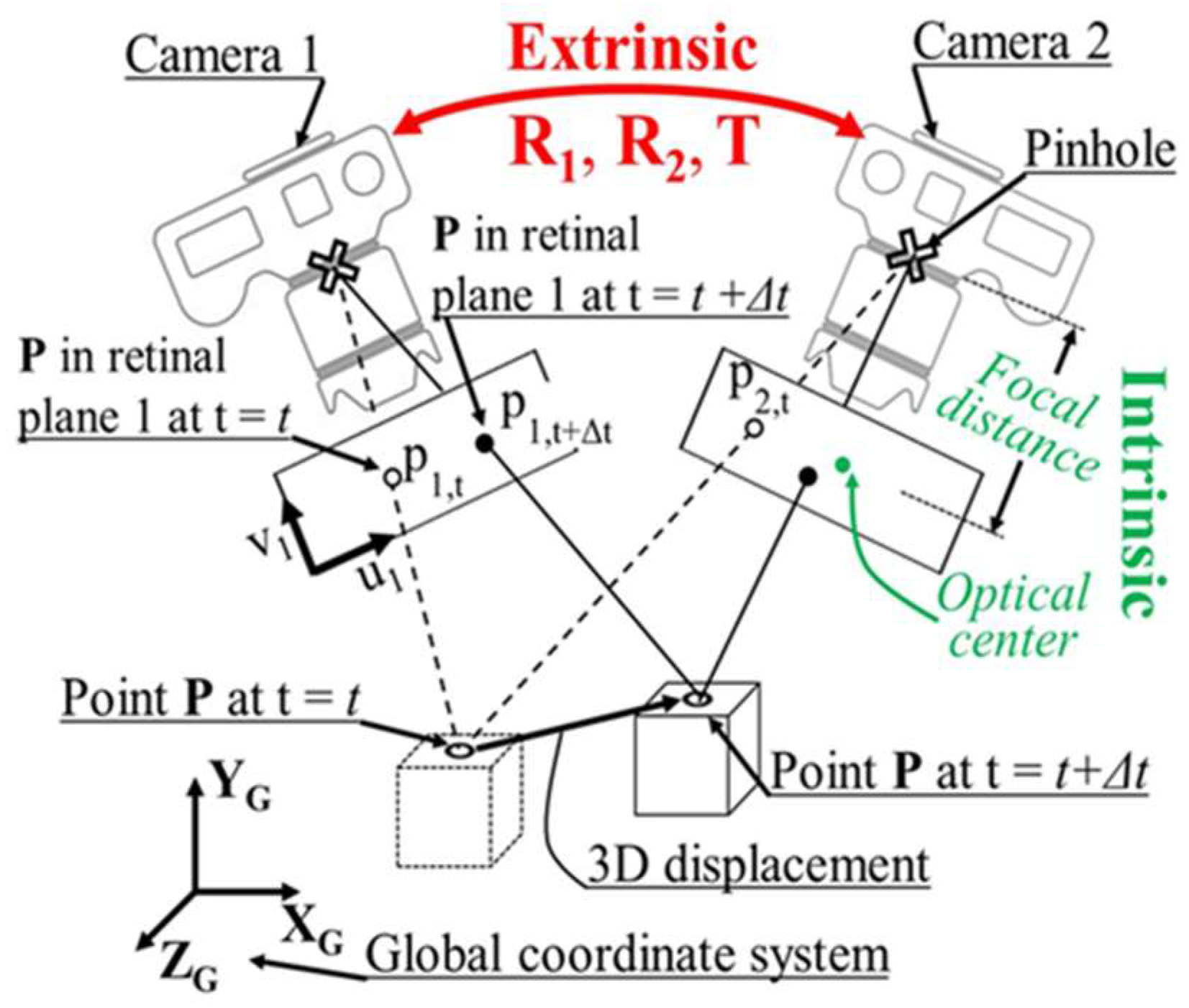


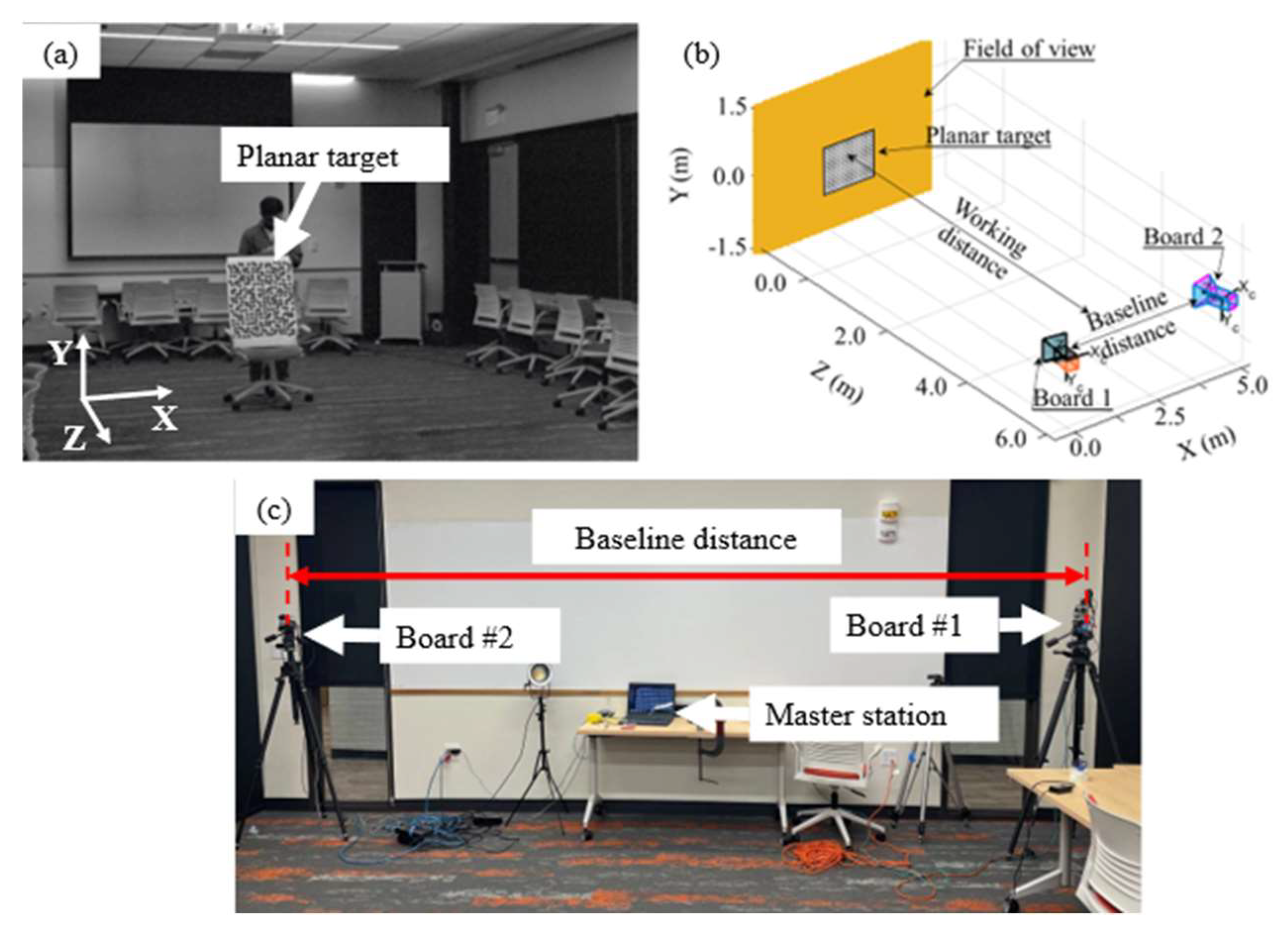



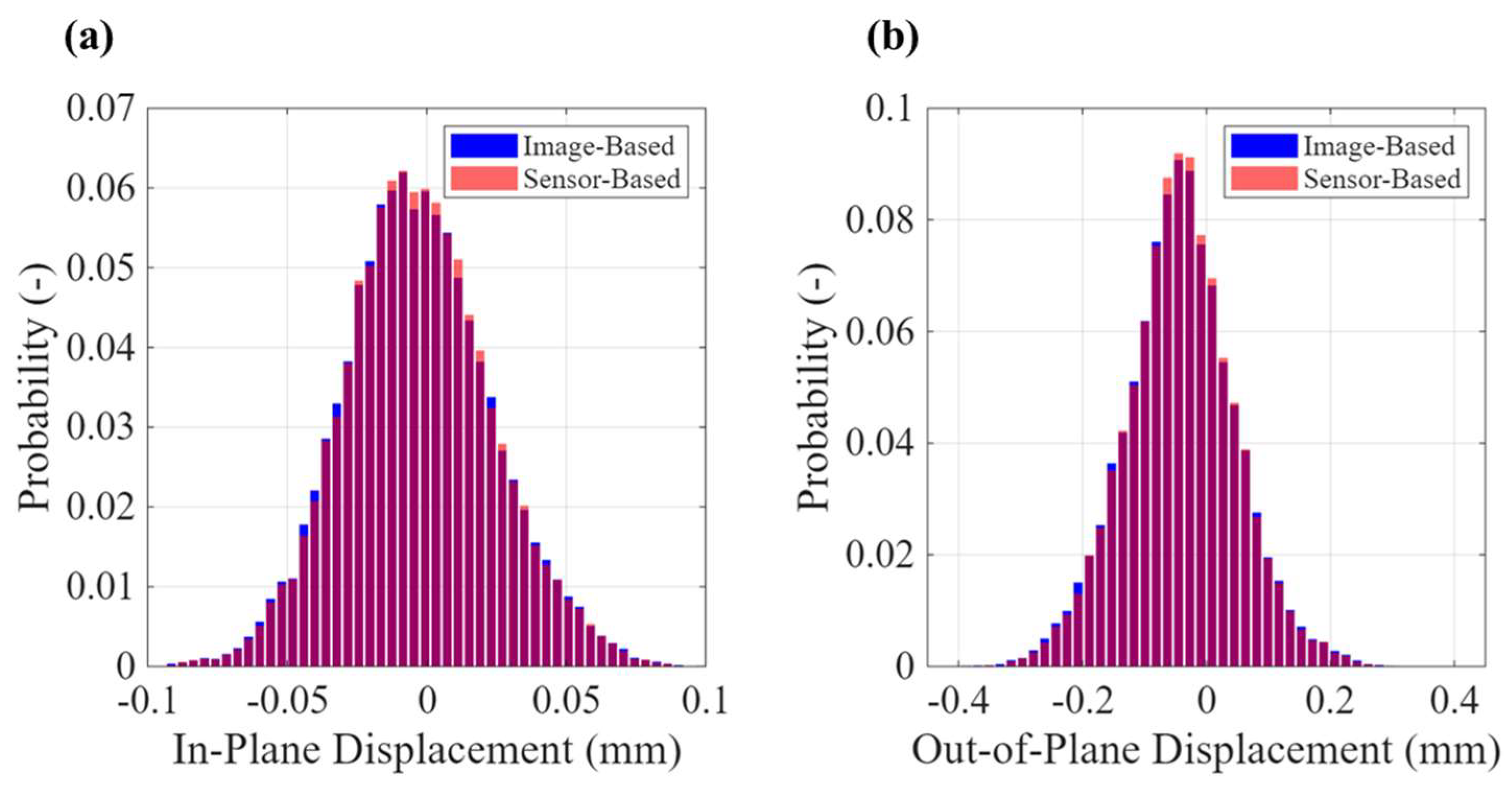
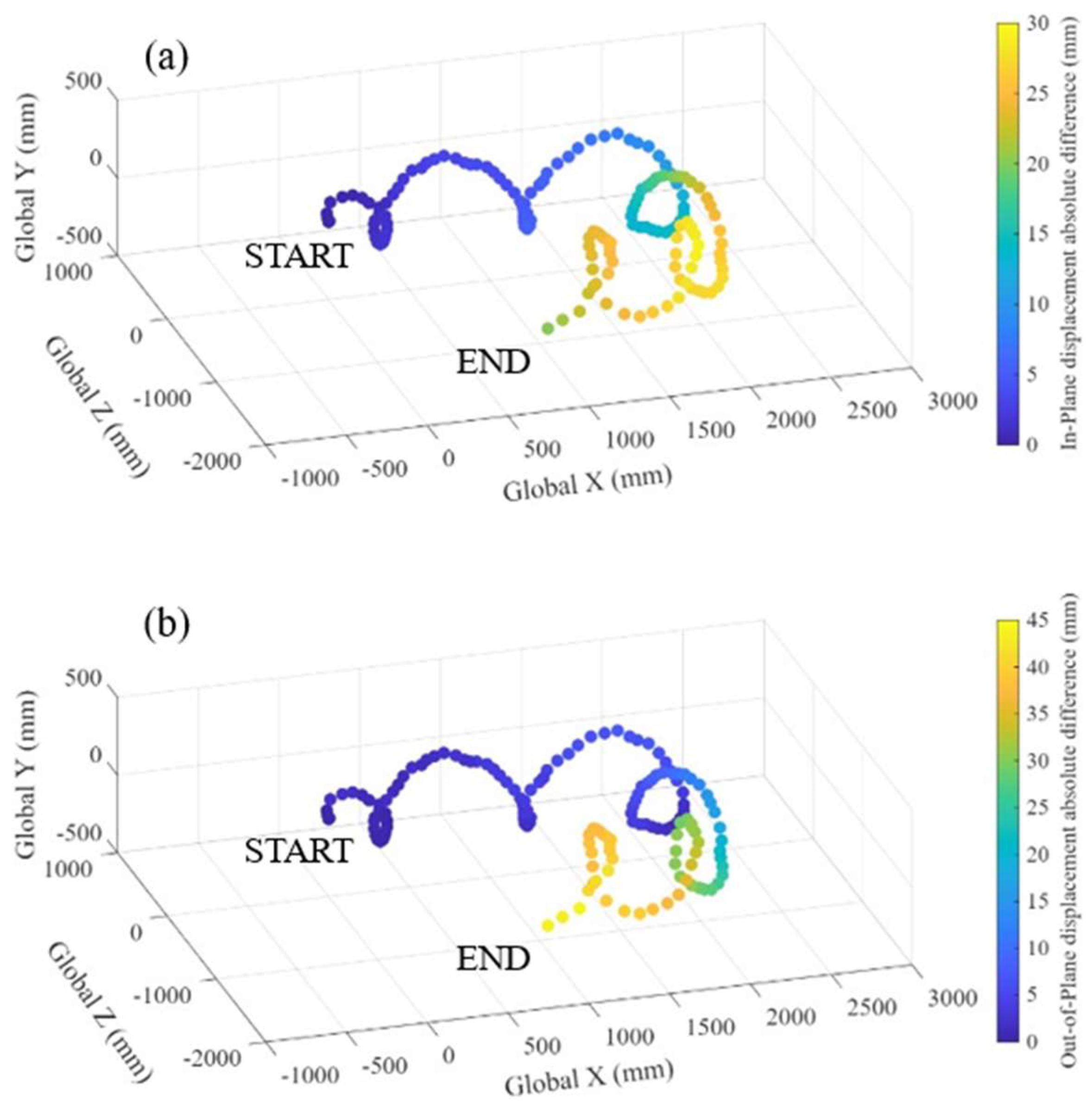

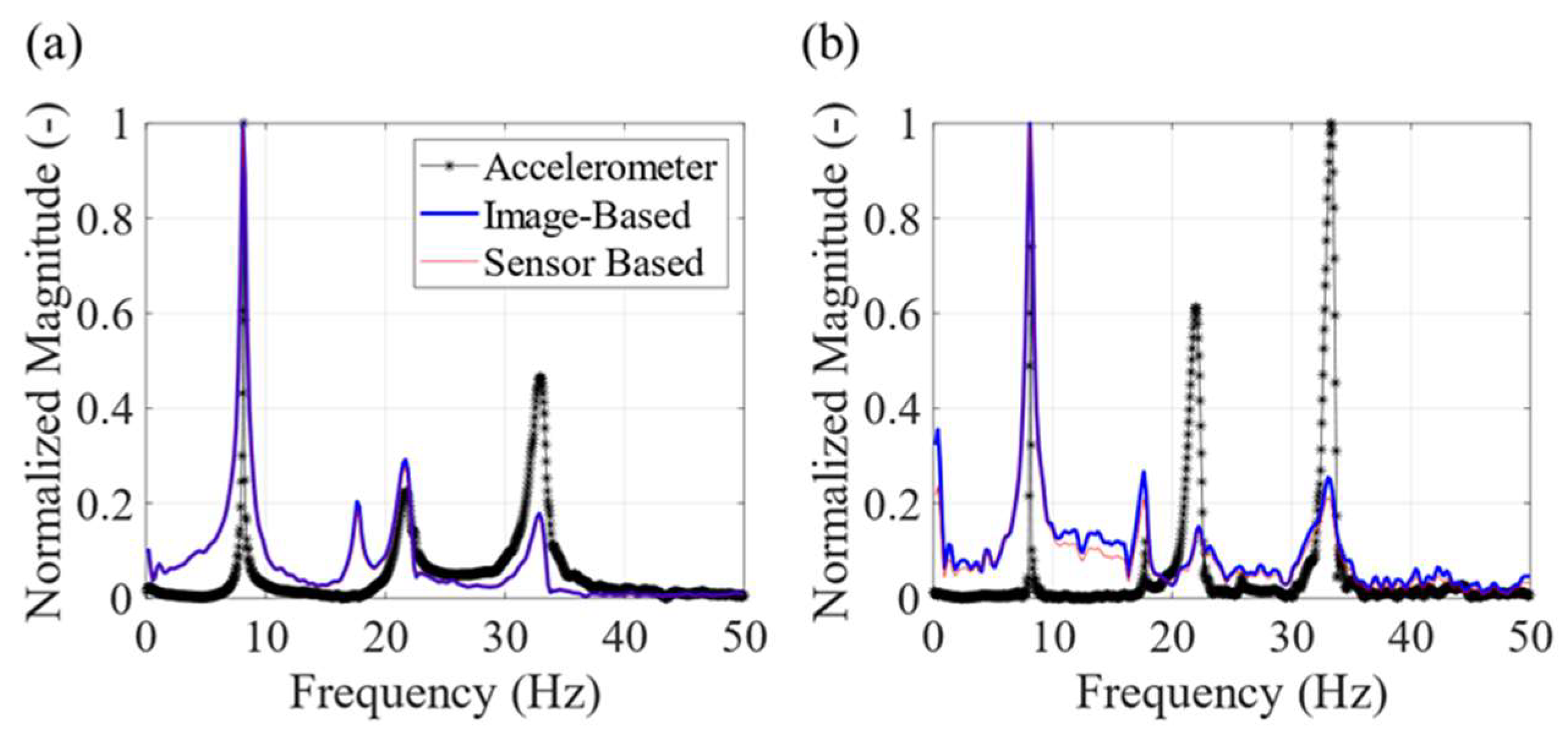
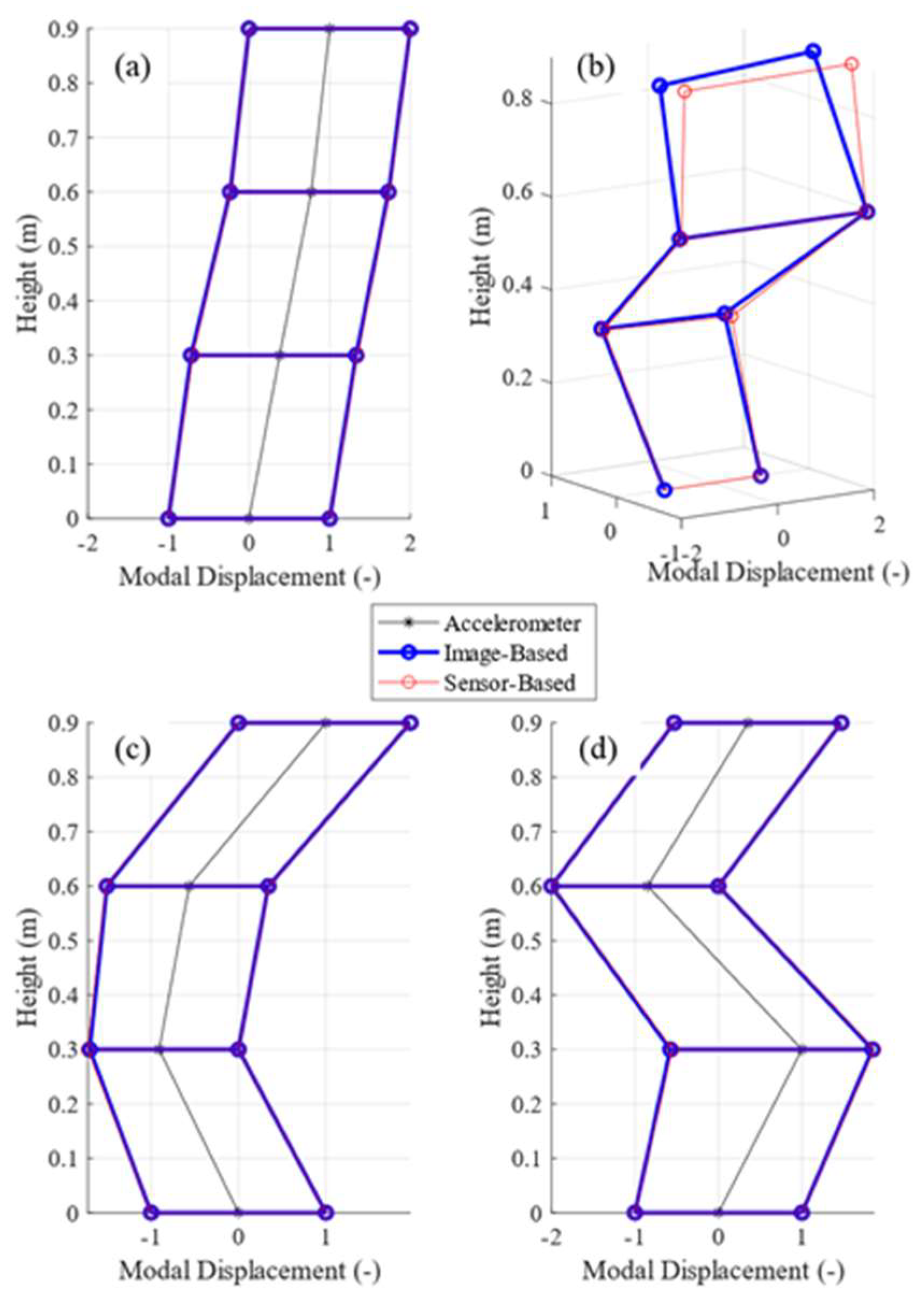

| Image-Based | Sensor-Based | ||||
|---|---|---|---|---|---|
| Cam 1 | Cam 2 | Cam 1 | Cam 2 | ||
| Intrinsic Parameters | cx (pixel) | 886.31 | 758.24 | 797.03 | 791.60 |
| cy (pixel) | 595.56 | 582.10 | 570.09 | 583.56 | |
| fx (pixel) | 2877.52 | 2933.78 | 2785.51 | 2767.76 | |
| fy (pixel) | 2901.98 | 2938.22 | 2796.26 | 2776.53 | |
| Extrinsic Parameters (Relative to Camera #1) | α (°) | 0.6246 | 0.5306 | ||
| β (°) | 0.0441 | 0.6560 | |||
| γ (°) | 38.060 | 36.488 | |||
| TX (mm) | −4337.93 | −4248.59 | |||
| TY (mm) | −17.284 | 29.105 | |||
| TZ (mm) | 1573.76 | 1363.76 | |||
| Time | (min:sec) | ~60:00 | ~5:20 | ||
| Image-Based | Sensor-Based | ||||
|---|---|---|---|---|---|
| Cam 1 | Cam 2 | Cam 1 | Cam 2 | ||
| Intrinsic Parameters | cx (pixel) | 501.24 | 518.25 | 505.16 | 517.40 |
| cy (pixel) | 1214.28 | 1004.94 | 1012.07 | 1006.71 | |
| fx (pixel) | 2448.08 | 2433.83 | 2460.45 | 2438.76 | |
| fy (pixel) | 2446.11 | 2432.51 | 2458.75 | 2437.64 | |
| Extrinsic Parameters (Relative to Camera #1) | α (°) | 1.1874 | 1.3939 | ||
| β (°) | 0.7717 | 0.7477 | |||
| γ (°) | 23.443 | 23.701 | |||
| TX (mm) | −520.67 | −524.33 | |||
| TY (mm) | 2.0725 | −3.3307 | |||
| TZ (mm) | 47.211 | 58.026 | |||
| Time | (min:sec) | ~15:00 | ~5:20 | ||
| Sensor-Based | Accelerometer (Difference) | Image-Based (Difference) |
|---|---|---|
| 8.0823 Hz | 8.1608 Hz (0.971%) | 8.0823 Hz (0%) |
| 17.6341 Hz | 17.7647 Hz (0.741%) | 17.6341 Hz (0%) |
| 21.6752 Hz | 21.6959 Hz (0.096%) | 21.6752 Hz (0%) |
| 32.8802 Hz | 32.9419 Hz (0.188%) | 32.8802 Hz (0%) |
Disclaimer/Publisher’s Note: The statements, opinions and data contained in all publications are solely those of the individual author(s) and contributor(s) and not of MDPI and/or the editor(s). MDPI and/or the editor(s) disclaim responsibility for any injury to people or property resulting from any ideas, methods, instructions or products referred to in the content. |
© 2025 by the authors. Licensee MDPI, Basel, Switzerland. This article is an open access article distributed under the terms and conditions of the Creative Commons Attribution (CC BY) license (https://creativecommons.org/licenses/by/4.0/).
Share and Cite
Bottalico, F.; Valente, N.A.; Niezrecki, C.; Jerath, K.; Luo, Y.; Sabato, A. Rapid 3D Camera Calibration for Large-Scale Structural Monitoring. Remote Sens. 2025, 17, 2720. https://doi.org/10.3390/rs17152720
Bottalico F, Valente NA, Niezrecki C, Jerath K, Luo Y, Sabato A. Rapid 3D Camera Calibration for Large-Scale Structural Monitoring. Remote Sensing. 2025; 17(15):2720. https://doi.org/10.3390/rs17152720
Chicago/Turabian StyleBottalico, Fabio, Nicholas A. Valente, Christopher Niezrecki, Kshitij Jerath, Yan Luo, and Alessandro Sabato. 2025. "Rapid 3D Camera Calibration for Large-Scale Structural Monitoring" Remote Sensing 17, no. 15: 2720. https://doi.org/10.3390/rs17152720
APA StyleBottalico, F., Valente, N. A., Niezrecki, C., Jerath, K., Luo, Y., & Sabato, A. (2025). Rapid 3D Camera Calibration for Large-Scale Structural Monitoring. Remote Sensing, 17(15), 2720. https://doi.org/10.3390/rs17152720







